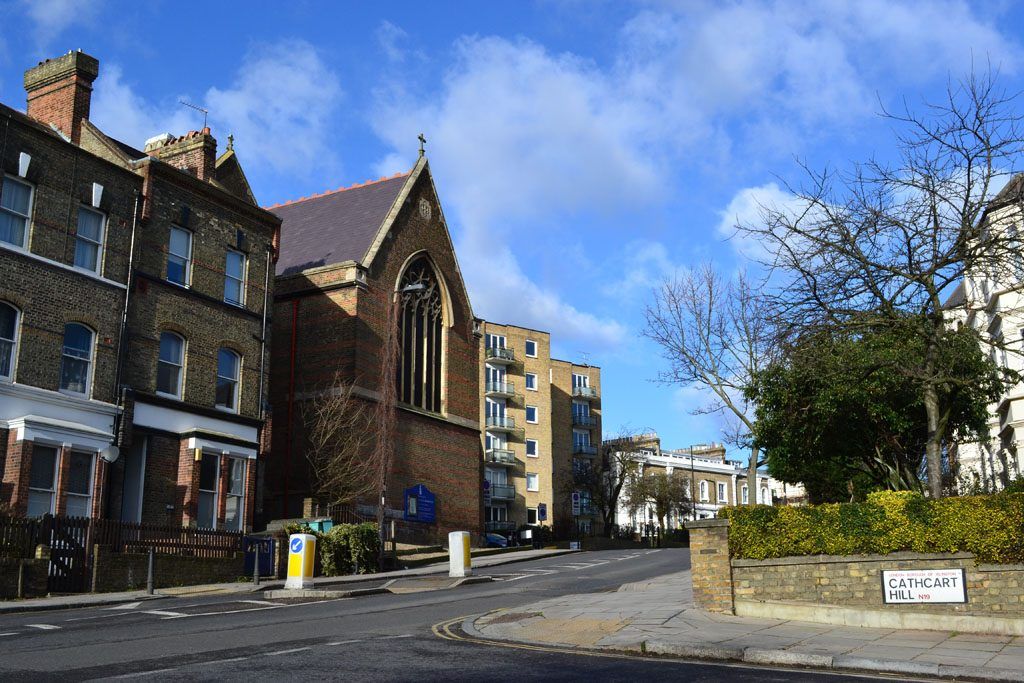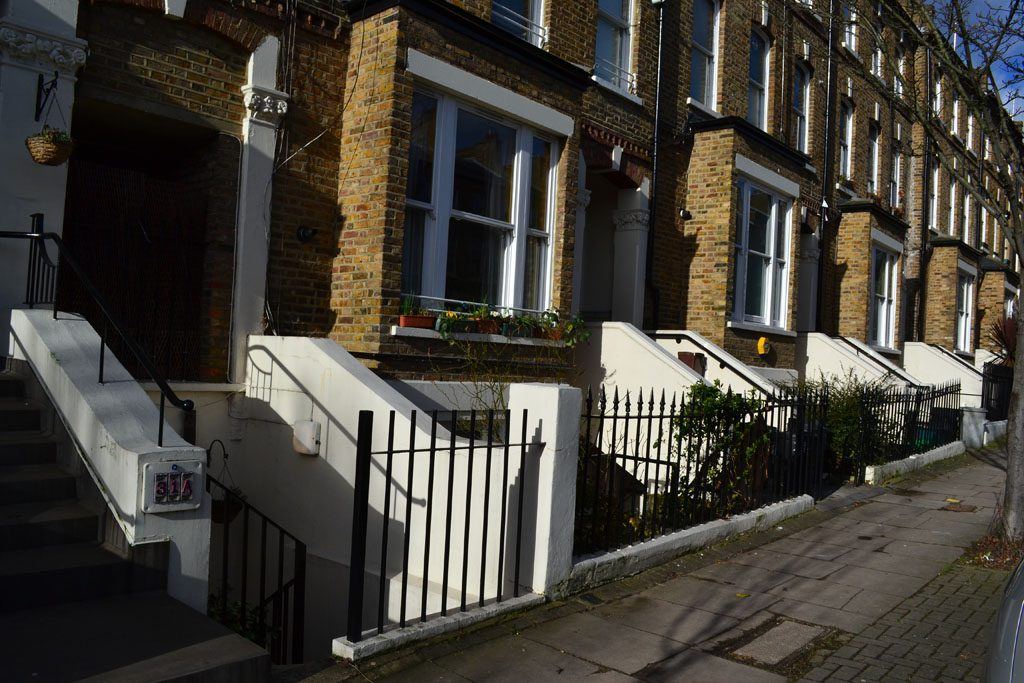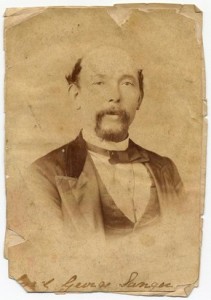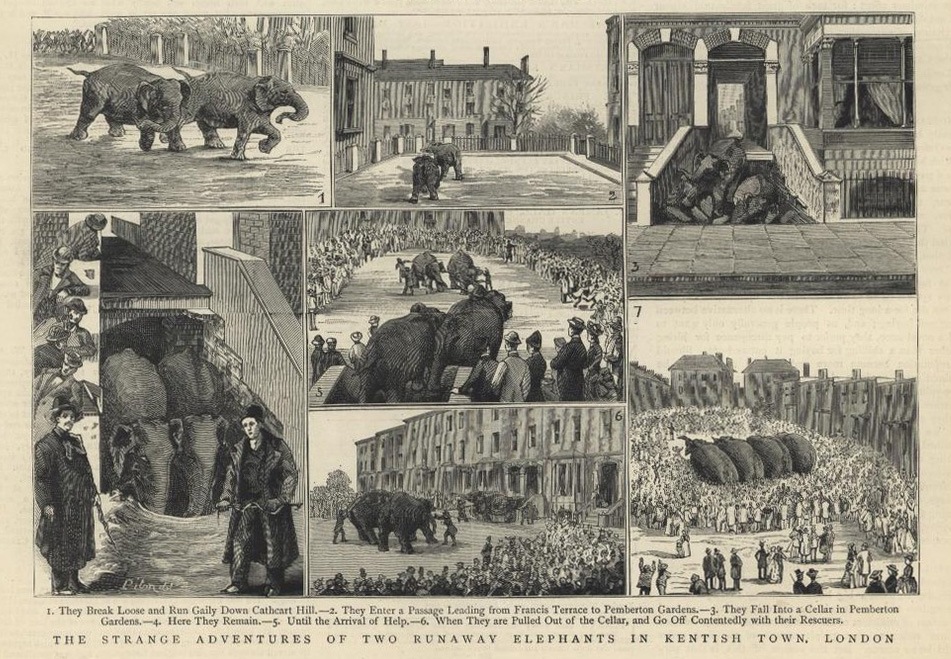Ten years ago we first published our take on what is probably Kentish Town’s most surreal story ever. Since many readers won’t have seen it – and it ‘s gone on to inspire the name of a cafe called the Lost Elephant Kitchen on Chalk Farm Road – we thought it worth revisiting on a wet September afternoon.
The fetching line-drawing above – published in The Graphic in 1884 – depicts one of the more random moments in Kentish Town’s documented history, the day two elephants ran amok through the local streets.
It’s fascinating to imagine details of the very Victorian tableau that gave rise to these ‘strange adventures’: various exotic beasts unloaded, two by two, from Midland Railway rolling stock in the heart of Kentish Town’s gritty Goods Yard.
They had been dispatched as part of a travelling circus booked to play at Agincourt Park, a field just off Mansfield Road now occupied by the road of that name. Interestingly, the British Mail newspaper report of the incident places Gospel Oak as in ‘Lower Holloway’, revealing much about how North London’s urban sprawl had yet to separate areas we now feel to be reasonably far apart.
Four elephants were to be among the highlights of the big show, but at a crucial moment of the unloading process the second pair to emerge from the trucks, named Ida and Palm, were suddenly startled. They bolted, making light work of flattening the yard gates, and knocking a keeper for six (dislocating his collarbone) before careering along Highgate Road.
Upon reaching The Vine, they veered right up one of the narrow lanes of which only Little Green Street remains today. The second collarbone casualty of the day was a man trampled underfoot by a herd of pedestrians stampeding for cover as their quiet backstreet momentarily became NW5’s very first trunk road (sorry).
Onwards charged Ida and Palm, where they made an optimistic and ultimately unsuccessful attempt to vault the wall of a large Baptist Chapel, before choosing the equally poorly appointed escape route of Twisden Road as a hasty alternative.

This led them trumpeting straight up Chetwynd Road, thundering across Dartmouth Park Hill and crashing down the then-private Cathcart Hill, the landowner’s fence proving less of a challenge than the chapel’s pious stone boundary.
The spooked elephants found themselves on Pemberton Terrace (below), where another ill-advised manoeuvre was to prove the final chapter of their flight. They made up the steps of the terraced houses, where “their combined weight on the flooring of the passage caused it to give way and they fell bodily into the cellar,” reported the papers.
Today the spot on Pemberton Terrace, squeezed between numbers 29 and 31, barely looks capable of fitting a single elephant (if you were planning such a thing) let alone a pair. Yet reports of the event went global (much of the online coverage to be found comes from papers published the following weeks in New Zealand), and the populist editors of The Graphic clearly knew such a story would make a compelling artwork.
The animals were finally removed from their basement level predicament with help from Jim and Rose, the other two circus elephants, who were brought along to pull them back out onto the pavement before a more sedate walk of shame back to Agincourt Park to make the scheduled show.

And what of the circus itself? It was run by Messers Sanger, among the most famous travelling troupes of the era, two brothers from a family of 10 siblings. George and John clearly inherited their enthusiasm for the travelling performance business from their father, a spirited navy pensioner who’d fought at the Battle of Trafalgar, losing three fingers plus a sizeable chunk of his head in the process, the result of some tasty slashes of a cutlass.
With his first pension payment, savvy Sanger Senior invested in a peep show and hit the road with his wife and family in tow. They subsequently added to their repertoire with a selection of human curiosities and a popular conjuring booth, which traversed the country’s popular fairgrounds.
His sons oversaw the family business’ later transition into a fully-fledged circus, complete with exotic animals, of which the unfortunate elephants were unwittingly to become the most notorious.

During the very same year as the elephant incident, the brothers split, the highly successful ‘Lord’ George eventually retiring with a menagerie of animals to a large farm just up the road in East Finchley.
From there he published a celebrated autobiography ‘Seventy Years a Showman’, before being brutally murdered with a hatchet by one of his staff for reasons unknown.
In a final gruesome twist, the perpetrator in turn then committed suicide by prostrating himself on the train lines at Highgate, and was decapitated. Yes, really.
As for the elephants? Their very own moment of soaraway tabloid attention ended more peacefully, the remaining circus years never again reaching the tusk-trembling drama of that visit to Kentish Town in the spring of 1884. A day that, dare we say it, they surely never forgot.
This article was originally published 2nd June 2013, updated 20th September 2023.
Hawke’s Bay Herald, 15th May 1884
British Mail, 1st April 1884
New Zealand Herald, 3 May 1884
Radio 4 Desert Island Discs archive with descendant of George and John Sanger, 1962 (audio)



4 thoughts on “Heard about the day elephants escaped in Kentish Town?”
Absolutely love this. ‘Walk of shame’! We’ve all been there…
Delightful story – thanks.
One detail, the story and the original illustrations show the elephants as having fallen through the steps up to an entrance that is shown as opening onto a passage right through the terrace. In your modern photos, that is the even narrower space to the left of the bay window, not the comparatively generous sloping garden of the adjacent semi-basement . That narrower space is in front of an opening that is now partly blocked and has no steps up to it.
That I think proves that what the elephants fell through was the entrance to a passage through to the back of the terrace, giving access to their back gardens etc. One wonders what would have happened if they had stormed the front door of one of the houses. That passage now appears to be disused and has probably been appropriated by one of the neighbouring houses. What’s interesting is that the steps appear to have never been reinstated, perhaps because the incident prompted visits for some time afterwards, and the residents didn’t want to lose their cachet of interest. By the time the interest waned, the need for the passage had also waned.
It does make the question of how 2 elephants could fall into such a small space even more pressing.
We took off on our photographic mission before discovering the most detailed press report about the incident (in the NZ Herald). That does indeed suggest that it was the small passageway from Francis Terrace that the elephants headed through, the only onward option left open to them.
Explaining such in-depth particulars about the geography of the steps laboured the flow of the story somewhat, so I took a bit of artistic license and jumped to the collapse itself. It seems the illustrators at The Graphic took similar license with their scale ratios of Ida and Palm, who look positively petite in pictures 3 and 4, but vast in the others.
The pressing question remains about the amount of space at the scene vs average elephant girth. Perhaps we need to revisit with the camera. Perhaps someone out there can shed further light on the popularity of the site as a tourist attraction in the following years? Perhaps the campaign for a plaque starts here?
Amazingly this wasn’t Palm, Ida, Jim and Rose’s first picture side by side in the papers- very media savy, these pesky pachyderms! Very probably the only time that two elephants ended up in someone’s cellar…ever! I have even visited the very nice couple that live in the basement flat.Their daughter couldn’t wait to tell all her friends at school. I nominated it for an Islington Green Plaque. Much more fun than whatever stuffy person they went for.
I have done a little research on this event, as best I can. There doesn’t seem to be much else beyond the articles. I can tell you that elephants would escape on a regular basis. Bit dangerous, but great publicity.
What was the purpose of the passage? Now that’s a mystery.
The main focus of my research, however, is our house (10 Cathcart Hill) when it was a girls’ boarding school. Not quite Kentish Town, but one of the pupils went on to marry into the Crane family who were local builders in Kentish Town.